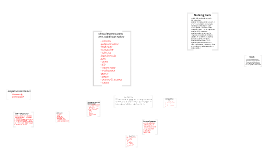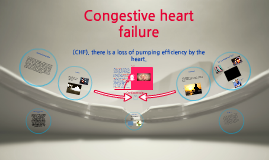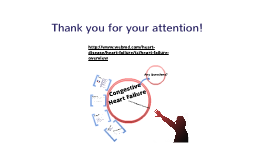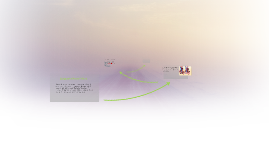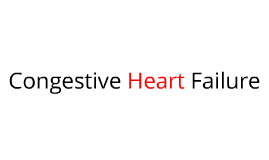Congestive Heart Failure
Transcript: Angiotensin Receptor Blockers (ARBs) ACE Inhibitor Doses Normal Heart vs. Heart Failure Monitoring for diuretics, thiazides, and loop diuretics Relieve symptoms Prevention of exacerbations Slow progression of disease Improve quality of life Daily weights Electrolytes (potassium, magnesium) Blood pressure Renal function (Serum creatinine, BUN) Drugs that worsen heart failure Lifestyle Modification Measurement of B-type natriuretic peptide (BNP) Echocardiogram for determining disease severity, left and right ventricular function Presence of medications known to worsen fluid retention, change left ventricular function and negative inotropic effects Symptoms of volume overload, low cardiac output or both Used in combination with loop diuretics to promote effective diuresis Preferred use in patients with mild fluid retention Not effective if CrCl < 30 mL/min Goals of therapy Types Drugs That May Worsen Heart Failure Nitrates/Hydralazine Doses Blood pressure Potassium Renal function: SCr/BUN Cough Angioedema Used to assist in fluid removal Block sodium reabsorption in the ascending loop of Henle Has not shown a mortality benefit but improves symptomatic relief of fluid overload, improves exercise tolerance, and prevents hospitalization Treatment Overview Drug Therapy Stage C Heart Failure Treatment Algorithm Prevent conversion of angiotensin I to angiotensin II Shown to reduce morbidity and mortality in heart failure and post-myocardial infarction patients Thiazide Source: ACC/AHA Beta Blockers Doses References Left Ventricular Dysfunction Heart Failure Life threatening condition in which the left side of the heart cannot pump enough blood to the body Right Ventricular Dysfunction Heart Failure Condition in which right side of heart loses its ability to pump blood effectively Goals: Reduce fluid retention Improve quality of life Reduce hospitalization Inhibits reabsorption sodium and chloride in renal tubules Beta Blockers Signs and Symptoms Heart Failure Treatment of Diastolic Heart Failure NYHA Functional Classification in Patients with Heart Failure Focus: Systolic Dysfunction Heart Failure Isosorbide Dinitrate and Hydralazine DiPiro, Joseph T. Pharmacotherapy: A Pathophysiologic Approach. New York: McGraw-Hill, 2005. Print. Hunt, HA, WT Abraham, and MH Chin. "Focused Update ACC/AHA 2005 Guidelines for Diagnosis and Managment of HF in Adults." Circulation 119 (2009): E391-479. Print. Lindenf, Eld J., NM Albert, JP Goehmer, and Et Al. "Exectutive Summary: HFSA 2010 Comprehensive HF Practice GUideline." J Card Fail 16 (2010): 475-539. Print. Rossamond, W. "Circulation." 117 (2008): E25-146. Print. Sutton, S. Scott. McGraw-Hill's NAPLEX Review Guide. New York: McGraw-Hill, 2011. Print. Lex-Drugs Online, Lexi-Comp Inc. Hudson, OH. http://www.crlonline.com/crlonline Journal of the American College of Cardiology 2003, 41:1519-1522. Journal of Cardiac Failure Vol 13 Nov 2007. Types of Heart Failure Stage A and Stage B Heart Failure Treatment Algorithm Diagnosis Work by blocking the mineralcorticosteroid receptor, the target site for aldosterone Spironolactone has been shown to reduce to reduce all-cause mortality in patients with moderate to moderately severe heart failure Eplerenone demonsatrated mortality benefit in patients with left ventricular dysfunction following MI Avoid if serum potassium is > 5 mmol/L or creatinine clearance is < 30 ml/min Negative Inotropic Effect Antiarrhythmics, beta blockers, calcium channel blockers, intraconazole, terbinafine Cardiotoxic Doxorubicin, daunomycin, cyclophosphamide, trastuzumab, imatinib, alcohol, amphetamines Sodium and water retention NSAIDs, Cyclooxygenase-2 inhibitors, rosiglitazone and pioglitazone, glucocortioids, androgens and estrogens, salicylate, sodium containing drugs ACE inhibitors Summary Patient Education and Lifestyle Modifications ACE Inhibitors ACC/AHA Stages of Heart Failure Signs and Symptoms Angiotensin Receptor Blockers Source: ACC/AHA, Dipiro Definition of Heart Failure 5 million heart failure patients 550,000 are diagnosed each year Mortality 30% - 40% per year after diagnosis What is heart failure Difference between systolic and diastolic dysfunction Causes Signs and symptoms Classification System ACC/AHA Stages of Heart Failure NYHA Functional Class Pharmacy Therapy Drug Therapy Options ACE Inhibitors ARBs Beta Blockers Diuretics/Thiazides/Loop Diuretics Nitrates/Hydralazine Other Agents Aldosterone Antagonists Digoxin Antiplatelet therapy Shown to reduce mortality in multiple large, randomized, placebo-controlled trials Block the sympathetic nervous system stimulation Reduce plasma norepinephrine References Inhibits Na/K ATPase pump causing increase in intracellular sodium and calcium concentration Has positive inotropic effects, such as increasing the contractility of heart Does not show mortality benefit but improves symptoms and reduce hospitalization Recommended in patients who remain symptomatic despite standard therapy with beta b lockers






